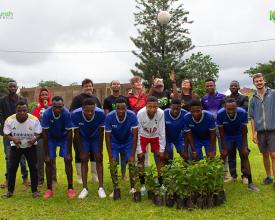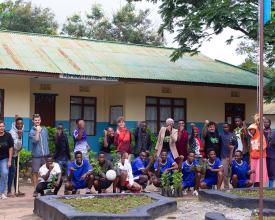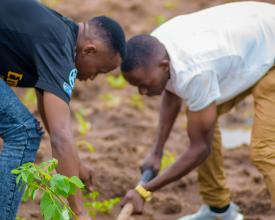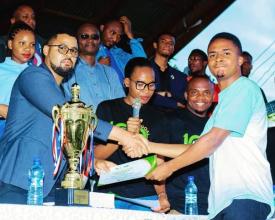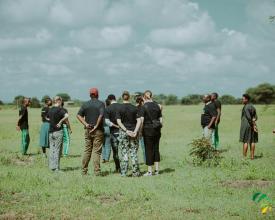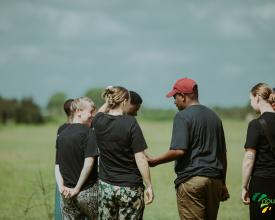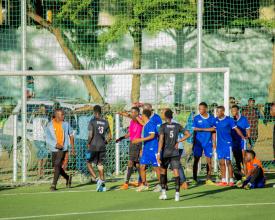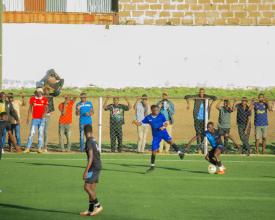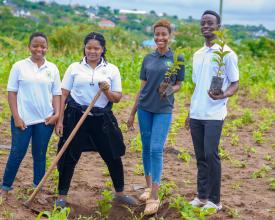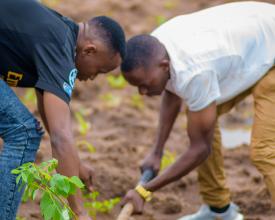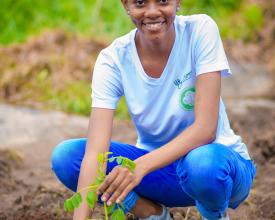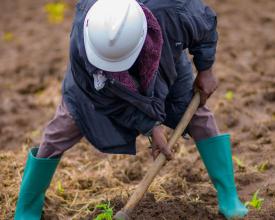
One Goal, 100 Trees – We play, We plant advocating environmental stewardship for Youth in Tanzania
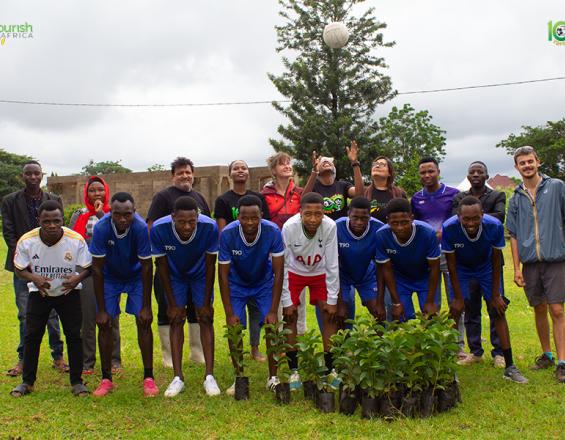
The ‘ONE GOAL 100 TREES’ WE PLAY, WE PLANT Campaign is a dynamic initiative targeting youth at universities and colleges, using football as a powerful tool to promote environmental conservation. The campaign links the excitement of football with the goal of planting trees, encouraging students to score goals both on field and for the planet. For every goal scored in matches or tournaments, a commitment of 100 trees to be planted per score. This approach not only fosters teamwork and competition but also raises awareness about environmental issues, empowering students to actively contribute to a greener future. Through tree planting events and collaborations with university football clubs, the campaign inspires a culture of sustainability and responsibility among young people.
Contexte
Challenges addressed
One Goal 100 Trees campaign aims to address envrionmental and educational challenges. The community lack education on how to preserve the environment, our campaign is focused on addressing the environmental issues specific to the community, in relation deforestation, and use of firewood for energy, our aim is to educate the community on these negative practices on environment and provide alternative ways of energy use, we provide specific trees species as energy source and some native trees for carbon sequestration.
Emplacement
Traiter
Summary of the process
The building blocks of this solution are intricately connected, each reinforcing the others to achieve successful outcomes. Collaboration and partnerships lay the groundwork, providing the necessary support and resources for the entire initiative. Landscape assessment ensures that the selected species are well-suited to the environment, increasing the likelihood of successful restoration. Football serves as a powerful engagement tool, drawing in youth and fostering widespread participation in conservation efforts. Finally, Monitoring & Evaluation (M&E) is integrated throughout the process, allowing for continuous improvement and ensuring long-term sustainability. Together, these components create a cohesive and effective strategy that leverages community engagement, scientific assessment, and continuous learning to drive impactful environmental conservation.
Building Blocks
Collaboration and Partnerships for Environmental Education
This building block centers on engaging universities, colleges, and local partners in environmental education and conservation efforts. We collaborate with football clubs and teams on campuses to promote climate change awareness and endangered species conservation. By leveraging these partnerships, we provide communities with the knowledge and tools needed to combat climate change. The collaboration extends to local environmental organizations, which offer technical support to communities. This interconnected approach is vital to the success of our campaign, which mobilizes resources, boosts participation, and amplifies the campaign’s impact through the collective efforts of educational institutions, environmental groups, government agencies, football stars, influencers, and corporate sponsors.
Enabling factors
Early involvement of partners is crucial for the success of this building block. By engaging them from the project's inception, partners gain a clear understanding of the objectives and can effectively contribute resources, such as providing staff for football campaigns. This early inclusion fosters a sense of ownership and commitment among partners, enhancing their support and ensuring the project’s goals are met.
Lesson learned
One key lesson learned is the critical importance of collaboration in environmental conservation projects. Success depends on involving all community levels—from youth and universities to local partners. Ensuring that these groups feel like true collaborators fosters a sense of ownership and commitment, which is essential for the project’s sustainability.
Landscape Assessment for Species Success
The purpose of this building block is to conduct thorough landscape assessments on the land owned by colleges and universities. By evaluating the environmental conditions, we can determine which species are best suited to thrive in these areas. This careful selection process ensures higher success rates for planting and contributes to more sustainable conservation efforts. The landscape assessment serves as the foundation for effective planting strategies, aligning species selection with the specific ecological characteristics of the land, ultimately leading to more resilient ecosystems.
Enabling factors
Key factors for success include having strong environmental technical expertise within the team and leveraging our partnerships with universities to access the land for assessment. These partnerships provide the necessary support and resources to conduct comprehensive evaluations, ensuring that the species selected are well-suited to the specific conditions of each site, which is critical for the long-term success of the planting efforts.
Lesson learned
One of the primary lessons learned is that not all tree species can thrive in the same region. Conducting land assessments is essential for understanding the unique environmental conditions of each area. This knowledge allows us to select species that are more likely to succeed, improving the overall effectiveness of our planting efforts. By aligning species with their ideal habitats, we enhance the sustainability and impact of our conservation initiatives.
Using Football as a Catalyst for Environmental Conservation
This building block leverages the widespread appeal of football to engage youth in environmental conservation efforts. Our environmental educators collaborate with college and university students, using football as a medium to raise awareness through posters, talks, and events focused on restoration methods. By tapping into the popularity of football, we make environmental issues more relatable and engaging, inspiring students to adopt sustainable practices. This approach not only educates but also mobilizes young people to become active participants in conservation, making them feel integral to the solution.
Enabling factors
Key factors for success include the strong connection between football and youth culture, which makes environmental messages more accessible. Football tournaments create excitement, fostering a sense of community and engagement around conservation topics. Additionally, the respect and influence of local football clubs and players are crucial in amplifying the campaign's impact, motivating young people to participate and take ownership of environmental issues.
Lesson learned
We learned that football is a powerful tool for connecting diverse communities and promoting inclusivity around environmental issues. It bridges gaps between marginalized youth, fostering a unified effort to conserve the environment. Engaging young women and girls in these activities is crucial for ensuring inclusivity. By using football, we strengthened relationships and mutual understanding, demonstrating that sports can be a unifying force in conservation efforts.
Monitoring & Evaluation: The Core of Sustainable Conservation
Monitoring, Evaluation, and Learning (MEL) is central to ensuring the sustainability of our tree restoration efforts. This building block allows us to track the progress of tree growth and refine our restoration strategies for better outcomes. We employ drones to capture before-and-after images, providing a clear visual comparison of the impact of our restoration work. By continuously assessing our efforts, we can make data-driven adjustments that enhance the effectiveness of our conservation initiatives.
Enabling factors
Critical to success is the integration of robust MEL tools and systems from the start of the project. Regular reporting and analysis are essential for adapting and improving our strategies as the campaign progresses. Access to advanced technology, like drones, enhances our ability to monitor and evaluate restoration efforts, providing detailed insights that guide ongoing improvements.
Lesson learned
We realised that incorporating MEL into our conservation efforts is vital for long-term success. New technologies, such as drones, have significantly improved our ability to track and assess the impact of our work. These tools not only provide more accurate data but also allow for more informed decision-making, ensuring that our restoration efforts are both effective and sustainable.
Impacts
The ONE GOAL 100 TREES campaign achieved several key outcomes:
Successfully planted hundred thousands of trees across campuses and local areas, contributing to increased green cover and improved biodiversity.
Engaged over 12,500 students in environmental conservation activities
Established strong collaboration with football clubs, environmental organizations over 5 of them, governmental agencies, and local influencer's, creating a support network that enhanced the campaign’s reach and effectiveness.
Developed environmental stewardship among the youth
Beneficiaries
- Youth in Unversities and Colleges
- Community around the Unversities & Colleges campuses
Sustainable Development Goals
Story
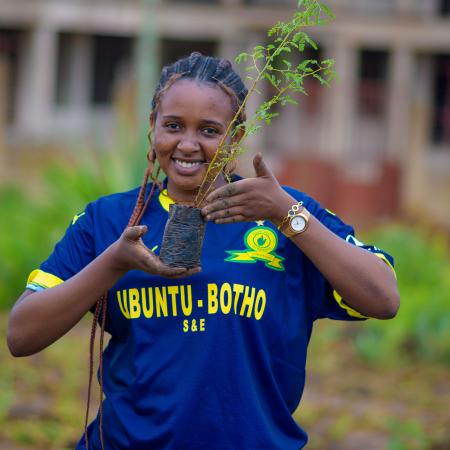
The project was born out of a desire to empower young people to take ownership of their environment. In Tanzania, where football is a beloved sport, I noticed a concerning lack of awareness and engagement among youth when it came to environmental stewardship. Recognizing the potential of football as a unifying and influential tool, we launched a campaign to connect with young people in a way that was both fun and meaningful.
As the campaign progressed, I witnessed a remarkable transformation. Young people who had previously been disconnected from environmental issues began to see themselves as vital contributors to the well-being of their communities and the planet. Through football, we were able to make environmental education accessible and relatable, sparking a change in mindset that extended beyond the individual.
One young woman, Glory Joseph, a Medical Student from Bugando, in particular, stood out. She became deeply involved in our campaign after participating in one of the football tournaments. Inspired by the connection between her love for the game and her newfound understanding of conservation, she began leading local initiatives to plant trees and educate his peers on sustainable practices. Her enthusiasm quickly spread, influencing others in her community to take similar actions.
This young woman’s journey is just one example of how the campaign has not only changed individual mindsets but also positively transformed entire communities. By embracing their role as environmental stewards, these young people are now driving real, tangible change in their neighborhoods and homes. It has been incredibly rewarding to watch them become the change they wish to see, empowered by a sense of responsibility and hope for the future.
